#Chinese folk religion
Text
Fox Spirits In Medieval Narratives: Gender Bias
The domestic worship of the fox described by Zhang Zhuo informs us that the fox spirit occupied an ambivalent position in family lives. That foxes were enshrined in private quarters and offered food consumed by humans suggests that they participated in the family as insiders. However, their supernatural power and animal nature inspired both reverence and fear, and preserved their identities as…
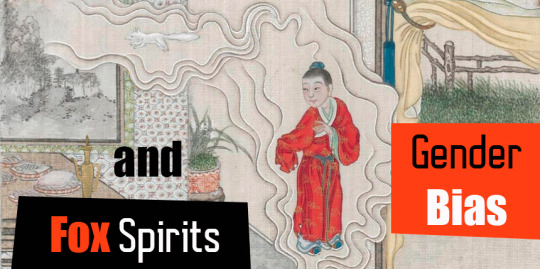
View On WordPress
#ancient China#Chinese culture#Chinese fairy tales#Chinese folk religion#Chinese history#Chinese mythology#fox#Nine-tailed fox#spiritual animal#Tang dynasty#Taoism#Taoist magic#Taoist practices
170 notes
·
View notes
Text
Cute Monkey King Temple Shirt
My friend recently visited a fairly new Monkey King temple in Bangkok, Thailand. This adorable shirt is only available in their onsite giftshop.

#sun wukong#monkey king#journey to the west#Monkey King temple#Chinese folk religion#Thailand#Thailand religion#shirt design
149 notes
·
View notes
Text
Chinese mythology. There are myths even older than Greek ones.
The myth of Chang'e, the Chinese moon goddess who was once a mortal woman and the wife of the hero archer Houyi, I know of at least 3 different versions. Of what led her to take the elixir of immortality that the gods had given to her husband as a reward for his saving humankind from the nine suns in the sky by shooting down eight of them.
1) She chose to because she was vain and feared growing old. 2) She felt like she had to because her husband wasn't good to her and she sought to escape him. 3) An apprentice of her husband's found out about it, broke into her home while her husband was away, and forced her to give it up with a knife to her throat. To keep it from falling into the hands of a villain, she swallowed it whole, and thus was forced to depart the mortal realm and be separated from the husband she loved for eternity.
Which one is the "real" or "right" one? Fuck if I know. I grew up with the last one, so that's the one I've been biased toward my whole life. Maybe none of them are "true". They're all made up stories. I highly doubt Chang'e has ever given a single fuck about what the mortals she'd left behind wrote or said about her. She's the goddess of the fucking moon and a great favorite of the emperor of heaven (hell, maybe he was that fond of her from the get go, he just went ahead and made her divine so she could join his court, because she's beautiful and the palace on the moon was unoccupied at the time, so why not). The fuck would she care.
97 notes
·
View notes
Text
Chinese Folk Religion: Snowy edition
Recent snow storms where I live has got me thinking: is there a deity responsible for snowfall and winter in traditional Chinese religion?
You got Frau Perchta/Holle in Germanic folklore, Yuki-Ona in Japanese Shinto folk beliefs, Skadi in Norse Paganism, and Morana in Slavic mythology, but I haven't ever heard of such a figure from my elders growing up.
So for this one, I had to actually use my limited Mandarin skills to do research, along with some help from more fluent family members and friends.
It turns out there are more than one traditional winter & snow deities in Chinese folklore. The reason I personally didn't hear of any is because, again, Chinese folk religion is extremely regional. There are central major deities that are uniform but the rest all differs from region to region. Han Chinese people have always spread out across several climate zones, from tropical to sub-arctic. Understandably, Gods and Goddesses associated with weather will differ from region to region. My Chinese side of the family hailed from a region where snowfall isn't very common, and winter isn't normally extreme. But look towards regions north of the Yellow River, and it's more upstream valleys in the Han Chinese heartland, it's a different story.
Teng'Liu: The Spirit of Snow and Frost
The first deity I can find is a figure named Teng'Liu (藤六). This is a male deity associated with snow itself. The "Liu" part if his name is the Chinese character for 6. Snowflakes typically have six arms/branches regardless of pattern. In Chinese numerology, the number 6 is also a number with "extreme Yin energy" (极阴). Snow itself is a thing with a lot of Yin energy too, as it's formed from water. Those familiar with Chinese cosmology should be familiar with the element's association with the cardinal direction of North. Which, again, is attributed with Yin. Thus explains why many forms of his folk names contains the number 6.
There is a folk ritual (which thankfully hasn't been practiced in over a century), which in Northern villages they used to offer up a young girl to this snow deity as a gift to appease him. The unfortunate girl would be tied up in a sack and left to the elements in the cold.
Teng'Liu occurs often in poetic works of literature as a stand-in for "snow". A fitting example is a work from Song dynasty writer and poet Yang Wanli, where he mentions "The Azure Lady pulls along Teng'Liu, as the Sun wilts away as she shakes (him)"** The meaning is obvious, but he mentions an Azure Lady, which takes us to another deity.
Qing'nu (青女): The Azure Lady
The second deity associated with snow and winter is a Goddess called Qing'nu, or "The Azure Lady", "The Lady in Turquoise", "The Lady in Blue", depending on the translation. She seems to be much more well-attested in ancient religious texts in addition to poetry and seems to predate the emergence of Teng'liu.
Attested in Huainanzi, a text compiled around 139 BC, "...three moons into autumn, Qing'nu emerges (from her home), and makes frost and snow fall..."
She is also mentioned as having white hair in a lot of classical Chinese poetry.
In traditional Chinese folk beliefs, Qing'nu resides in the moon and is a companion/handmaiden of the Moon Goddess Chang'E (嫦娥). Every year at the end of autumn, she will emerge from the moon palace to perform her duty: to bring winter, frost, cold, and snow. She will descend upon Mount Qing'yao (青要山), where she will bathe in the waters there to purify herself. She will then start playing her seven-stranded lyre and snow and frost will fall upon the earth to cleanse the land of impurities and diseases (until they come back next summer).
BTW Mt. Qing'yao is an actual mountain in Henan Province. The mountain itself does play a rather big role in traditional beliefs and in Taoism. In fact, there is a hill adjacent to the mountain named Qing'nu's Peak (青女峰), where on the peak there stands a pillar-like rock. In local folklore they say that lone pillar looks like a slender lady, standing atop the mountains looking down upon the earth. It marks where the Goddess herself stands every year to bring winter. The locals call it "the maiden's rock" (闺女石).
Legend has it there was once a gorgeous palace at the foot of this mountain where Qing'nu would stay in temporarily during winter. This could possibly be a reference to some type of structure used as a shrine or temple. Today only the spring that flowed in the palace remain. The very spring that, according to folklore, that the Goddess herself bathes in to purify herself. Today, young ladies from around would make pilgrimage to that spring to welcome her arrival on 14th day of the ninth month. A second pilgrimage would also be made on 13th day of the third month as she is supposed to leave and return to the moon. (the dates are the dates in the Chinese lunar calendar).
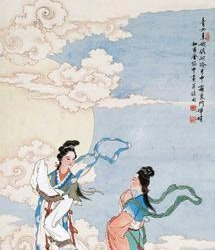
From these we can see while those deities are all associated with snow, they are seen by the people as very different. Teng'liu is very embodiment of the weather phenomenon, kind of like Jack Frost in American folklore. The fact there were rituals to appease him means that he is seen as a very unpredictable and volatile force. A spirit which has to be controlled under strict orders from a higher Celestial deity (天神): Qing'nu. Think of her as the Chinese counterpart to Frau Holle, a spirit attributed to making snow fall but not the snow itself. Or rather, think of those two like Helios and Apollo in Greco-Roman mythology. One being the sun itself and the latter being the one who pulls the sun across the sky.
This was fun, i hope all you folks who are trying to connect to their ancestral beliefs found this useful.
**translation might be off, sorry. Middle Chinese is difficult even for fluent speaker who studies old literature, plus this was Middle Chinese in it's poetic form.
#chinese folk religion#folklore#chinese folklore#history#ancestors#witchblr#witches of color#han chinese#chinese diaspora#folk taoism#chinese mythology#chinese religion#folk religion#polytheism#world religions
52 notes
·
View notes
Photo

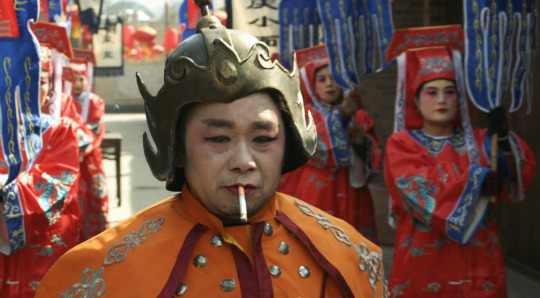
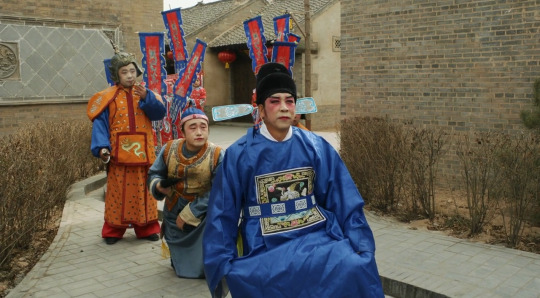

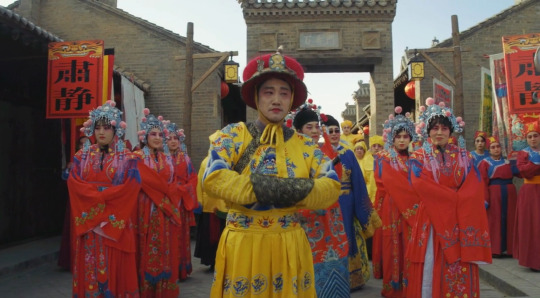
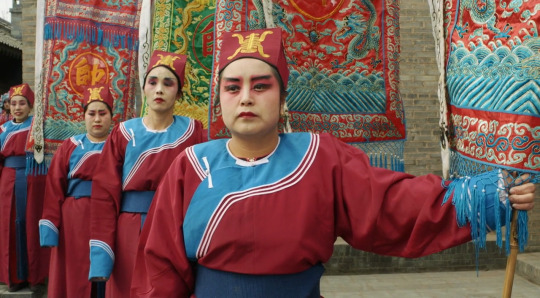
The Hedonists (Jia Zhangke, 2016)
#The Hedonists#Jia Zhangke#Zhangke#Sanming Han#Jindong Liang#Yuan Wenqian#china#fashion#culture#2016#short film#smoke#colour#chinese folk religion
134 notes
·
View notes
Note
This a little too complicated for a ask but, how do Chinese demons work, how do they come into being, how do their powers work, how do they get their powers, what types exist, what is the general feel about them since it not totally extermination, what type of civilization they have, what can they make like how do they get there weapons and armor, how strong are they physically, and for a joke you think the Armstrong canon is a mortal weapon that a author might not have thought of they wrote a demon is immune to all mortal weapons. (This why you don’t power scale historic mythical figures DEATHBATTLE.)
welcome back, bud! and, hoo boy that's a lot of questions ajhdadbjawdw
i'm assuming you mean in my au, but for most of them, i gotta point towards actual folk religion beliefs, since that is what i'm leaning on. and as most thing with real mythology, it's Complicated xvx
so, Chinese demons come in many shapes and sizes and have multiple origins and power levels, sometimes (but not always) related to their origins. i'd have to direct you to my own sources, aka the ever wonderful @journeytothewestresearch and his articles!
this one explains some of the basics and a few nuances of JTTW demons while also offering the book from which the information was acquired, and the one below is a wonderful compilation of a myriad deities in folk religion, as well as some info on how worship and the pantheon functions.
but for the sake of convenience, i'll do a quick run down under the read more uwu
to make a very complicated and deep topic veeery short, though. demons (Yao) are simply one class of being, like mortals and immortals. some demons (Yaoguai) are animals who cultivated (either through the Dao or Buddhist merit) themselves into demonhood. some become cultivated enough to shed their animal form and assume human form, which is generally considered pretty advanced. sometimes, they are just animals that for some reason grew to be Very Old, grew very large, and became demons. sometimes, they are restless spirits who lingered and cultivated into Yaojing. some even, are celestials and immortals who committed some misdeed or crimes, and were punished into being demons, either for a set time or until they've redeemed themselves somehow.
overall they don't have a specific "civilization", they are also part of the Middle Kingdom (the mortal realm) and exist within it or on the skirts of it. most of them are not unlike highwaymen or a very dangerous animal; they attack people on roads, they have mountain lairs and call themselves "mountain kings" over the region they control, etc. as demons, they often are on a bad path, killing and stealing and causing grief wherever they are, and so the locals learn to avoid them as much as possible and call on exorcists if the demons become too much of an issue. but there are demons who seek a better path, cultivate on their own without causing mischief, and those may even gain an appointment in the heavenly bureaucracy.
in very short terms, you were reborn in a lesser tier of the reincarnation realms and thus you have to work your way back into the human path by doing good deeds, or you dig yourself a deeper grave by causing chaos. generally, humans fear demons because they more often than not cause chaos, illnesses, bad luck, etc. and if uncovered, they'll likely be expelled from wherever they are.
as for weapons, some of them are let's say signature weapons. in Esoteric Buddhism and folk religion, how a deity is depicted is imperative to asking for their blessing or summoning them; their pose, colors, clothes, mudras, chants, and indeed even weapons, are very clearly detailed so that you won't be fooled by a masquerading demon impersonating them. therefore some deities are assigned weapons as the signifier of who they are. for example, Sun Wukong has had many forms and depictions over the years, but you Know it's him by the Ruyi Jingu Bang. same for Bajie and his rake.
however, some are weapons that were stolen in some way or another from higher beings. a common trope in JTTW is that demons were acolytes or underlings from higher deities, and left service with a few trinkets from their masters, which are then returned once the demons are defeated.
as for what they can do, a few are depicted as being able to produce pills of immortality for instance, from their own merit as cultivators, so again depending on their level of cultivation, they can accomplish quite a lot.
and if i remember right, Wukong himself is a demon (sorta) who is impervious to mortal weapons. he cultivated to reach Copper Head Iron Arms, a skill that makes him impervious of any attack. he also has his warding circle, in which he draws a circle on the ground with him staff, and everything and everyone within the circle is protected.
EDIT: depending on the region and myth, you might also see yaksha and rakshasa being mentioned. they are imports from India thanks to Esoteric Buddhism, but like demons, there are good and bad individuals among them. i don't know enough about Hinduism and Esoteric Buddhism to go in-depth on the topic, but know that they are Different But Similar xvx
43 notes
·
View notes
Text
A Dragon!
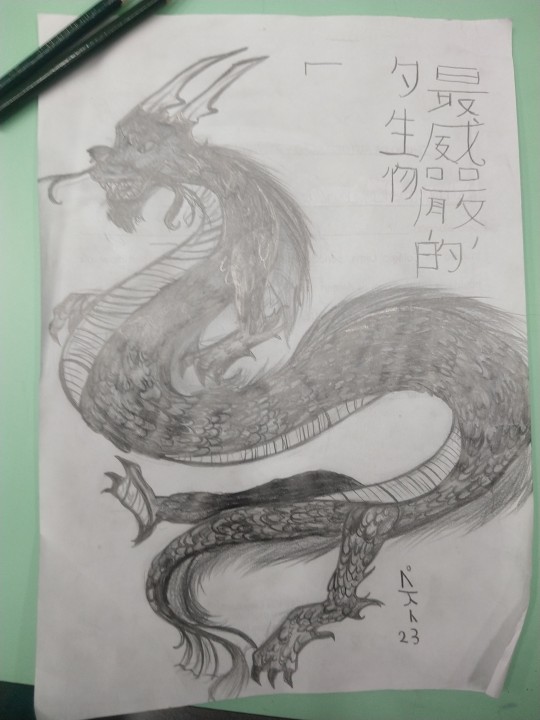
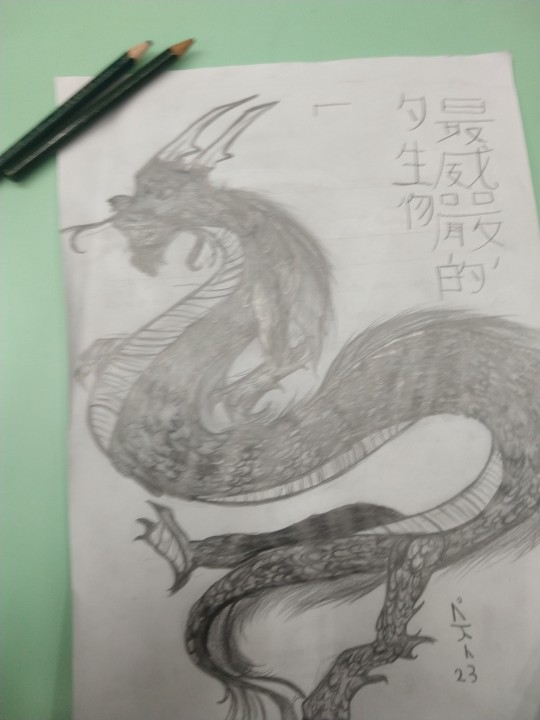
#art#anime#chinese#china#chinese culture#chinese folk religion#chinese folklore#chinese dragon#asian#asian culture#asian dragon#pencil#traditional drawing#tradicional drawing#drawing#traditional art#original art#sketch art
20 notes
·
View notes
Text
I NEED YOUR HELP 🫵
(Reblog for bigger sample size pls)
Im writing a poem for my literature assignment and I need as many water Goddesses as you can find.
Any and every culture is welcome though I already have Greek, Norse, Indian, Chinese and Aboriginal (indigenous Australian)
ANY AND EVERY ONE COUNTS EVEN IF THEY WONT MAKE IT TO THE FINALE COPY
(I’m a huge mythology nerd so I’ll read into them anyway)
IF THIS POST WORKS AND DOES WELL I’LL ADD THE POEM ONCE THE ASSIGNMENT IS DONE
#please educate me#I'm white#I don't know much#poems and poetry#help please#school#mythology and folklore#greek mythology#norse mythology#hinduism#chinese folk religion#aboriginal culture#pagan#folklore#mythology#reblog#history#literature#general#dark academia#I'm also just genuinely interested#if you know any moon/star/night Goddesses that's also good#won't help the assignment#but I'll enjoy it#australia#fyp#urgent#classics#tumblr fyp#art
3 notes
·
View notes
Text
冬至 (Dongzhi Festival) 2023


Today is the Winter Solstice Festival and the beginning of counting nines. This is my first year celebrating Dongzhi! I don't have any Chinese family to celebrate with, so I will sit with my cat and be happy that I am myself. I have slowly been finding my Chinese culture over the past few years.
This is how I am celebrating Dongzhi this year:
To count the 9*9 days until spring arrives I am going to crochet a granny square each day.
I made tangyuan in a brown sugar and ginger broth
I made a chicken and miso broth for dumpling soup
I am going to drink rice wine. I hope I can find some with osmanthus flowers, as I think they are very pretty and they are the flower of my Chinese birth month.
I am going to remind myself that this season is about the darkness giving way to light. Yang is now increasing as the days will literally become longer. The season is changing, life is continuing. Everything in its time and place.
I don't think of myself as a particularly spiritual person. I'm just someone who believes tradition and ritual are powerful psychological tools that can be used to better your life. Attaching this cultural tradition (the winter solstice) to a mental shift (things are changing in a positive direction) is important to me, and I am pleased that I can incorporate my folk religion in meaningful ways in my everyday life.
Please reblog with ways that you celebrate winter solstice! It can be cultural traditions, familial traditions, your own practices, or just mental ways you prepare for the new season or reflect on this day.
4 notes
·
View notes
Text
How Asian Spirituality Differs from Western Occultism
How Asian Spirituality Differs from Western Occultism
The way Asia treats spirituality is incredibly different from the Western Occultism sphere: they are nearly polar opposites. Therefore it can be incredibly confusing and misleading to try to apply the mindset from one practice to the other.
“Asia” refers to mainly South & East Asian practices. I am not sure how much this applies to central Asian practices.
“Western Occultism” is used as a…
View On WordPress
#asian#asian magic#asian occult#buddhism#chinese folk religion#east asia#metaphysical#occult#south east asia#Spirit Work#taoism
56 notes
·
View notes
Text


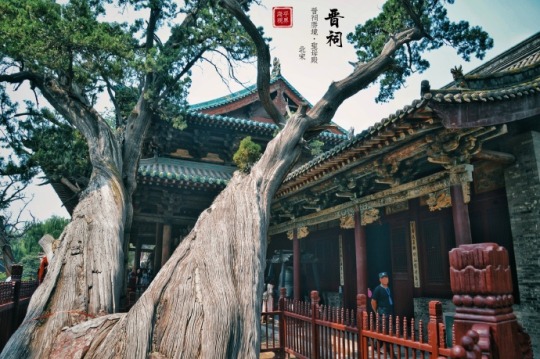
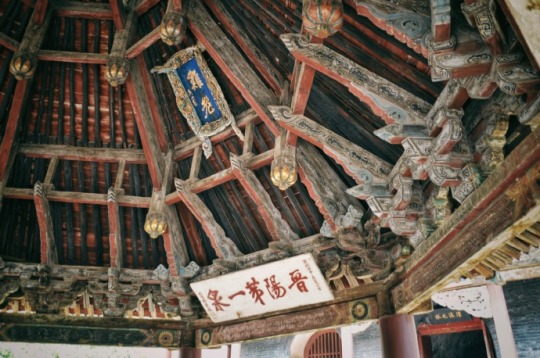
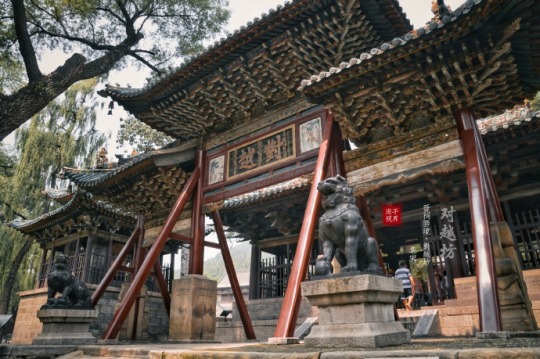




The Hall of the Holy Mother: One of the Oldest Places of Worship
The Hall of the Holy Mother (聖母殿) in Jinci Temple (晉祠), Shanxi. Built during the reign of Emperor Renzong (仁宗) of the Northern Song dynasty (1023-1032).
The hall is part of the ever evolving temple complex founded about one and a half thousand years ago. Over the centuries of countless transformations, it has accumulated buildings of various periods and styles.
The temple is dedicated to Shuimu (水母), The Old Mother of Waters, witch-goddess of Chinese lore, appearing in the form of a dragon, a snake or a charming lady with a sword and a yoke.
Photo: ©鱼雁江南, 雪夜魚舟
#ancient china#chinese culture#chinese mythology#taoism#chinese architecture#song dynasty#wooden architecture#wooden buildings#chinese customs#taoist#chinese folk religion#chinese temple#religious art#temple architecture#taoist deities#goddess#goddess worship#mother goddess#great mother#chinese folklore#dragon art#dragon
252 notes
·
View notes
Note
When's Sun Wukong birthday too?
The Monkey King has several birthdays/religious celebrations. Here is a list written by a worshiper from Singapore:

I've independently verified numbers one to four via almanacs and informants. I think five and six are maybe traditions in her family.
This is a picture I took during Monkey's 8/16 lunar birthday (i.e. no. 2) in Hong Kong in 2018.

I saw your other ask. I'll answer that when I get the chance.
#sun wukong#monkey king#journey to the west#birthday#chinese folk religion#Chinese religion#JTTW#lego monkie kid#LMK
111 notes
·
View notes
Text
My grandfather was the one who told me this when I was a child. In Chinese astronomy, Venus is named after the god Taibai Jinxing (his name means "great white gold star"), an honored and beloved advisor of the emperor of heaven. He has the brightest star in the night sky named after him for his great wisdom and the brightness of his mind.
#witches of color#special interests#chinese mythology#chinese folklore#chinese folk religion#langblr#astronomy#asian witch#chinese witch#taoism
62 notes
·
View notes
Photo




The Hedonists (Jia Zhangke, 2016)
#films watched in 2023#The Hedonists#Jia Zhangke#Zhangke#seis#2016#Sanming Han#Jindong Liang#Yuan Wenqian#china#fashion#culture#short film#chinese folk religion#cars#motorcycle#smoke#long shot
141 notes
·
View notes
Text
Seeking resources
Hi there and hello! I'm dusting off this page just briefly as I'm searching for resources.
Are there any modern Chinese folk religion practitioners here that might be able to point me in the direction of modern practices and observances - something accessible to an omnist (neopagan). My little gremlin is Chinese on his dad's side and I would like to find some resources that can help me help him connect spiritually to that heritage without my interfering completely or teaching incorrectly. Are there ways we can incorporate Chinese magic and deities around the house in a natural way?
I am learning Mandarin - my spouse speaks Mandarin but no longer reads it fluently. So resources in Chinese are great but unless it's in pinyin they are unfortunately not helpful.
TIA!!
#neopagan#neopaganism#Chinese folk religion#Chinese folk resources#interracial family#interracial religion
2 notes
·
View notes
Text







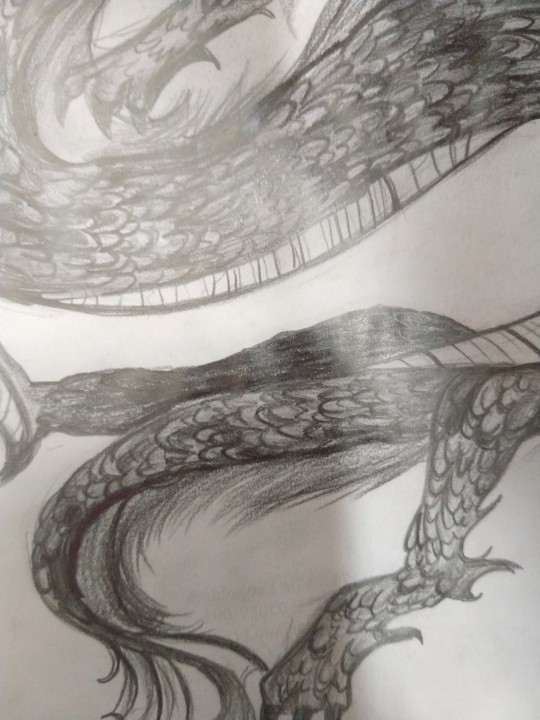
A Dragon!
#art#anime#china#chinese folklore#chinese folk religion#chinese culture#chinese dragon#chinese#original content#pencil#tradicional drawing#tradicional art#traditional illustration#traditional drawing#traditional sketch#traditional art#asian dragon#asian#asian culture#mitologia#folklore#pencil sketch
18 notes
·
View notes